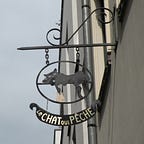White Nights and Cloudy Skies
Throughout most of June and July here in northern Denmark the “white nights” adorn the sky, a beautiful sight although they make it next to impossible to gaze at the stars. Only the most luminous stars can peek through on the southern and south-western sky — Arcturus, the Polar star, and the ‘summer triangle’ with Vega, Deneb and Altair forming the three points. Sometimes around 2 or 3 am one can almost discern the Big Dipper. It is no wonder that the Swedish word for the Milky Way is the Winter Way because that is when we can see it again. And before you ask, of course we cannot see the Northern Lights, either, only in winter. There are, of course, those rare summer nights when one cannot see anything at all because everything is covered by clouds — just had a couple of those.
The sunsets are spectacular when not obscured by clouds, but even when partially covered there can be some fantastic formations, feeding the imagination with all types of pictures — is it a huge dragon eating up a bunch of piglets, or is it an angry giant yelling at another dragon, or maybe, as below, a playful elephant and a stuffed animal? This is, of course, the type of play which can also take place in broad daylight when white fluffy clouds form a heart or piglets running across the sky. And then there are those evening clouds coloured by the setting sun that make them look like run-away candy-floss.
A couple of nights ago there was another shining object in the sky to the south, a full moon that almost obliterated those few stars one can actually see, mainly in the southern sky. The moon is closer to earth than it has been in years and looked absolutely spectacular through the branches of the maple next to the house where I live.
The white nights are a phenomenon that most of the northern hemisphere enjoys, apart of course from the northern-most parts where the sun does not set, but around here the phenomenon is caused by the sun lighting up the clouds high in the sky — one can actually see a band of grey or black clouds turning white the higher they soar. The sun is just 12° below the horizon and that makes the sky from St Petersburg (well known for its white nights) to Scotland to Canada provide those white skies.
What would in winter be called ‘the middle of the night’ is in summer when the sun rises, often with beautiful pink and orange colours spreading across the north-eastern to eastern sky.
Visitors from southern Europe often have difficulties sleeping at night up here in the north and do not understand why we do not have dark curtains — I have seen visitors becoming increasingly red-eyed from lack of sleep, but on the other hand, they cannot bear the darkness in winter, either. Bear in mind that in winter the sun rises around 9 am and sets again around 3.30 pm, so no wonder we glory in the light in summer — as I have often explained to visitors, we hibernate in winter like the bears while we are active around the clock in summer, like the bears.
Enjoy your summer wherever you are.
